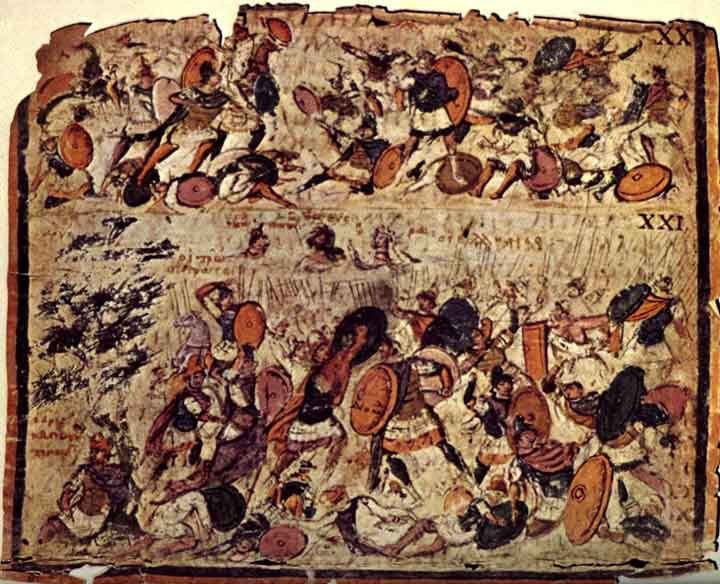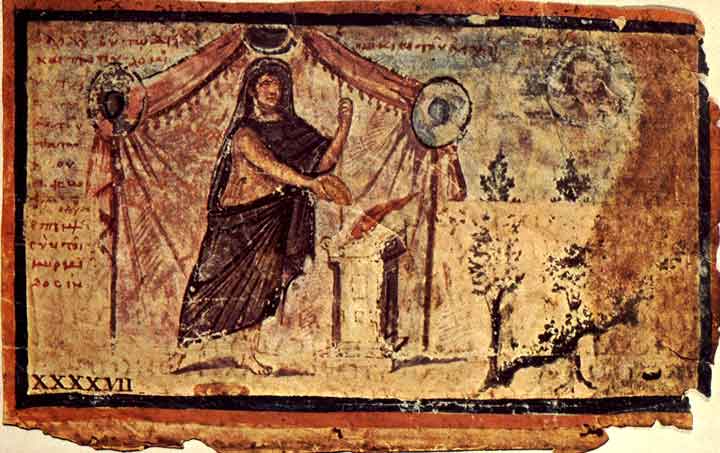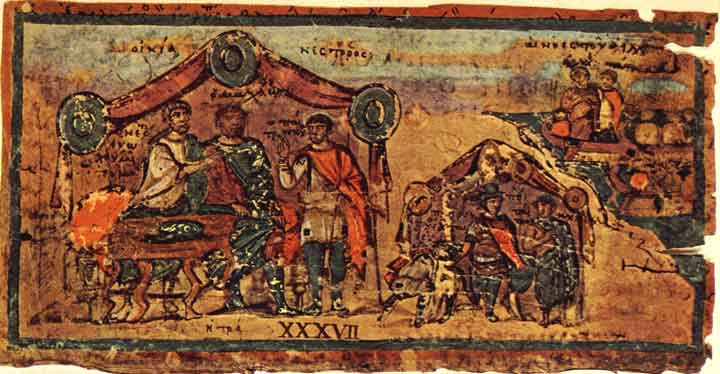.
The Ambrosian Iliad (Milan, Biblioteca Ambrosiana, Cod. F. 205 Inf.) is a 5th century illuminated manuscript the Iliad of Homer. It has been reduced to a series of miniatures cut out of the manuscript. It is one of the oldest survivng illustrated manuscripts. In addition it is the only survivng portion of an illustrated copy of Homer from antiquity and, along with the Vergilius Vaticanus and the Vergilius Romanus, one of only three surviving illustrated manuscript of classical literature to survive from antiquity.

Battle Scenes, Ambrosian Iliad Pictures 20, 21
The Ambrosian Iliad or Ilias Picta (Milan, Biblioteca Ambrosiana, Cod. F. 205 Inf.) is a 5th-century illuminated manuscript on vellum, which depicts the entirety of Homer's Iliad, including battle scenes and noble scenes. It is considered unique due to being the only set of ancient illustrations that depict scenes from the Iliad. The Ambrosian Iliad consists of 52 miniatures, each labeled numerically. It is thought to have been created in Alexandria, given the flattened and angular Hellenistic figures, which are considered typical of Alexandrian art in late antiquity,[1] in approximately 500 AD, possibly by multiple artists. The author(s) first drew the figures nude and then painted the clothes on, much like in Greek vase painting.[2] In the 11th century, the miniatures were cut out of the original manuscript and pasted into a Siculo-Calabrian codex of Homeric texts.
Example of Greek Uncial Text, folios XXIX
Comparisons of texts per page to other late antique manuscripts (Vatican Vergil, Vienna Genesis)[3] has led some to speculate these miniatures were originally part of a large manuscript.[4] This manuscript was unlike other illuminated manuscripts in its lack of gilding. Instead, the author(s) chose yellow ochre to represent gold within the individual images, i.e. the gold cuirasses of noble figures, and the halo of Zeus (folios XXXIV).[5]
Cardinal Angelo Mai, librarian of the Ambrosiana in the early 1800s, became convinced that the manuscript was from the 3rd century, and therefore philologically extremely important. He labelled the miniatures, and applied harsh chemicals to the manuscript in an attempt to improve the legibility of the text. His actions caused the miniatures' colors to bleed through the pages and left them in the damaged state they are in today.[6]
The Capture of Dolon, folios XXXIV
Today the Ambrosian Iliad is held in the Biblioteca Ambrosiana in Milan, Lombardy, Italy, which is also the manuscript's namesake. It was purchased from Genoese collector Gian Vincenzo Pinelli's library and added, by the famed Cardinal Federico Borromeo, to the Biblioteca Ambrosiana on June 14th, 1608.[7] The manuscript's images can be viewed on the Warburg Institute Iconographic Database.
Wikimedia Commons has media related to Ambrosian Iliad.
References
Coarelli, Filippo (1962). "The Painted Cups of Begram and the Ambrosian Iliad". East and West. 13 (4): 317–335. JSTOR 29754619.
Bury, Jane (1897). "Early Christian Miniatures". ProQuest.
Kleiner, Fred (2012). Gardner's Art Through the Ages. Cengage Learning. pp. 85, 86, 248–250. ISBN 978-0495915423.
Bare, Ceil (2009). "Achilles and the Roman Aristocrat: The Ambrosian Iliad as a Social Statement". Florida State University.
Alexander, Shirley (1968). "Problems of Metal Usage In Some Late Antique and Early Christian Manuscripts". ProQuest.
Bare, Ceil (2009). "Achilles and the Roman Aristocrat: The Ambrosian Iliad as a Social Statement". Florida State University.
"10 Collections for the Bibliophile". Museum Network. 2018-05-11. Retrieved 2018-12-04.
Further reading
Guglielmo Cavallo: Osservazioni di un paleografo per la data e l'origine dell'Iliade Ambrosiana, in: Dialoghi di Archeologia 7, 1973, p. 70–85
Weitzmann, Kurt, ed., Age of spirituality: late antique and early Christian art, third to seventh century, no. 193, 1979, Metropolitan Museum of Art, New York, ISBN 9780870991790; full text available online from The Metropolitan Museum of Art Libraries
See also : Greek Mythology. Paintings, Drawings
| Ancient Greece
Science, Technology , Medicine , Warfare, , Biographies , Life , Cities/Places/Maps , Arts , Literature , Philosophy ,Olympics, Mythology , History , Images Medieval Greece / Byzantine Empire Science, Technology, Arts, , Warfare , Literature, Biographies, Icons, History Modern Greece Cities, Islands, Regions, Fauna/Flora ,Biographies , History , Warfare, Science/Technology, Literature, Music , Arts , Film/Actors , Sport , Fashion --- |
Retrieved from "http://en.wikipedia.org"
All text is available under the terms of the GNU Free Documentation License



